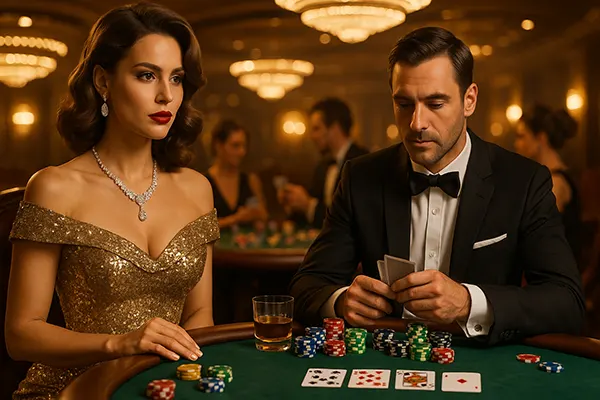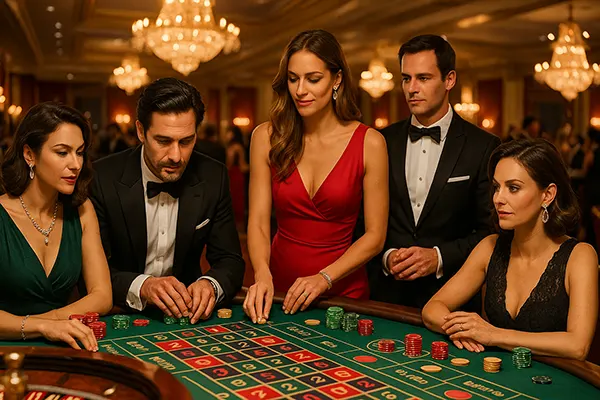
The Image of Casinos in Cinema: From Classics to Modern Films
Casinos have long been a backdrop for cinema, embodying luxury, suspense, and human ambition. From the smoky halls of mid-20th-century films to today’s glossy productions, the casino has been portrayed not merely as a place of gambling, but as a stage where style, tension, and character intersect. Jewellery, elegant fashion, and the aesthetics of gaming tables all contribute to the larger-than-life image that audiences remember.
Casinos as Symbols of Power and Glamour
Throughout cinematic history, the casino setting has symbolised power, wealth, and exclusivity. Films like “Casino” (1995) by Martin Scorsese reveal the intricate balance between glamour and the darker realities of crime and control. The casino is presented as a world where fortunes are made and lost, yet the surrounding aura of jewellery, expensive suits, and luxury cars masks the hidden tensions.
Directors often use casinos to highlight contrasts between glittering surfaces and dangerous undercurrents. The glamour of sequinned gowns, sparkling diamonds, and polished interiors creates a visual feast that conceals the corruption beneath. This visual duality makes the casino a compelling cinematic metaphor.
By the 2000s, films like “Ocean’s Eleven” reinforced the idea of the casino as a fortress of wealth and sophistication. The film’s meticulous styling, paired with fast-paced heist sequences, painted casinos as playgrounds for masterminds rather than just gamblers.
The Role of Jewellery and Fashion in Classic Films
Classic cinema frequently framed jewellery as a silent narrator of status and influence within the casino space. In “Casino”, Sharon Stone’s character Ginger is inseparable from her dazzling diamond sets, which mirror her volatile lifestyle. Jewellery here is more than decoration; it becomes a symbol of identity and fragility.
Fashion choices, such as tailored tuxedos and silk gowns, establish the hierarchy of the casino’s elite. The glamorous costumes accentuate not only character traits but also the broader allure of the casino as an aspirational space. The viewer associates diamonds, pearls, and golden accessories with privilege and risk.
These visual details shaped the cultural imagination of casinos as places where elegance and danger coexist, amplifying the intensity of the on-screen drama.
Modern Representations of Casinos on Screen
In modern cinema, the image of casinos has evolved, adapting to the aesthetics of contemporary storytelling. While the sense of luxury remains, films place greater emphasis on dynamic action and international intrigue. “Casino Royale” (2006) exemplifies this shift by reimagining James Bond’s world through a sleek and modern lens.
The poker table scene in “Casino Royale” illustrates not only Bond’s strategic brilliance but also the visual grandeur of high-stakes play. Jewellery, watches, and tailored suits create a refined atmosphere, underscoring the psychological tension of each move. Here, fashion functions as both armour and identity marker.
Contemporary films often combine traditional elegance with a faster pace, showing casinos as global hubs of suspense where technology, espionage, and style collide.
Jewellery and Style as Cinematic Language
Modern films use jewellery as part of their cinematic language, drawing attention to character roles and emotional arcs. In Bond’s world, a luxury watch is not just an accessory but also a tool, seamlessly blending function with prestige. Jewellery helps to highlight contrasts between sophistication and vulnerability.
Female characters often embody this symbolism through understated but striking pieces. A single diamond necklace can carry the same narrative weight as a dramatic line of dialogue, signalling confidence, attraction, or impending betrayal.
These stylistic choices ensure that audiences connect the casino environment not only with gaming tables but also with an atmosphere where every detail contributes to the tension.

The Casino Aesthetic in Contemporary Storytelling
Beyond individual films, the aesthetic of casinos has become embedded in cinematic culture. Directors rely on the imagery of velvet tables, glowing lights, and shining jewellery to create an instantly recognisable mood. The setting continues to function as a shorthand for high risk and high style.
In ensemble productions like “Ocean’s Eleven”, the casino’s design becomes a character in its own right. The architectural lines, security systems, and luxurious interiors support the narrative as effectively as the cast, reinforcing the casino’s role as a cinematic icon.
By 2025, the cultural memory of these films remains strong. The blend of jewellery, fashion, and suspense ensures that the casino continues to be used by filmmakers to explore ambition, deception, and human psychology.
Why Casinos Remain Cinematic Icons
Casinos persist as a favourite setting because they combine glamour with unpredictability. Jewellery and fashion elevate characters, making them memorable, while the gaming tables provide an arena for tension and conflict. This balance resonates with audiences across generations.
As cinema evolves, directors continue to adapt the casino aesthetic, using modern filming techniques and updated styles to retain its relevance. Whether in heist films, spy thrillers, or character-driven dramas, the casino remains a timeless symbol.
Ultimately, the portrayal of casinos in film reflects not just the allure of gambling, but the deeper fascination with risk, identity, and spectacle. From diamonds glittering under neon lights to tailored tuxedos at the poker table, the aesthetic continues to shape how we imagine the world of high stakes.
